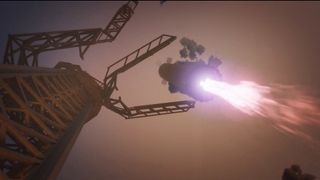SpaceX teases catching Super Heavy booster with 'chopsticks' on upcoming Starship test flight (video)
"Aiming to try this in late July," SpaceX's Elon Musk previously wrote on social media.
The next flight test of SpaceX's Starship could include a new milestone, according to a teaser included on a video of highlights from the rocket's fourth flight test.
SpaceX posted the video on X (formerly Twitter) on Thursday (July 4), which contains a montage of milestones from Starship's fourth flight test that took place on June 6. The video shows clips from ignition, lift off, booster separation and the reentries of both the Starship upper stage and its Super Heavy booster.
At the end of the video, an animation depicts a 400-foot-tall (122-meter-tall) Super Heavy coming back in for a landing at Starship's launch tower, known as "Mechazilla," beside the words "Next up" and "Flight 5," suggesting the company plans to attempt to catch the booster on its upcoming flight test. SpaceX plans to catch Super Heavy on its launch tower so the rocket can be refurbished and relaunched more efficiently and on shorter timeframes, the company has said.

SpaceX CEO and founder Elon Musk has suggested as much on social media as well. "Aiming to try this in late July!" Musk wrote on X last month, following Starship's fourth flight test.
The company previously posted a 60-second animation of the "chopstick" arms on the huge Mechazilla launch tower catching a Super Heavy booster as it comes in for a landing at Starbase, SpaceX's site in South Texas.
Prior to that, on June 27, the company posted a short video on X of Mechzilla's chopstick arms grasping a stationary Super Heavy as it sat upright on its launch mount. "Starbase team testing the tower chopsticks for the upcoming catch of a Super Heavy booster," SpaceX wrote in the video's description.
Starship has launched four times to date: In April and November 2023, and on March 14 and June 6, 2024. Each test was more successful than the previous one, ticking off additional milestones every time.
Get the Space.com Newsletter
Breaking space news, the latest updates on rocket launches, skywatching events and more!
On its first flight, Starship's two stages failed to separate and the vehicle was detonated in fewer than five minutes. On its most recent mission, both Starship and Super Heavy reentered Earth's atmosphere intact, both making ocean splashdowns.
The massive vehicle is designed with off-world destinations in mind. SpaceX wants Starship to reach Mars, and potentially help settle humans there, while NASA is planning to use the rocket to land crews on the moon during the Artemis program.
Join our Space Forums to keep talking space on the latest missions, night sky and more! And if you have a news tip, correction or comment, let us know at: community@space.com.

Brett is curious about emerging aerospace technologies, alternative launch concepts, military space developments and uncrewed aircraft systems. Brett's work has appeared on Scientific American, The War Zone, Popular Science, the History Channel, Science Discovery and more. Brett has English degrees from Clemson University and the University of North Carolina at Charlotte. In his free time, Brett enjoys skywatching throughout the dark skies of the Appalachian mountains.